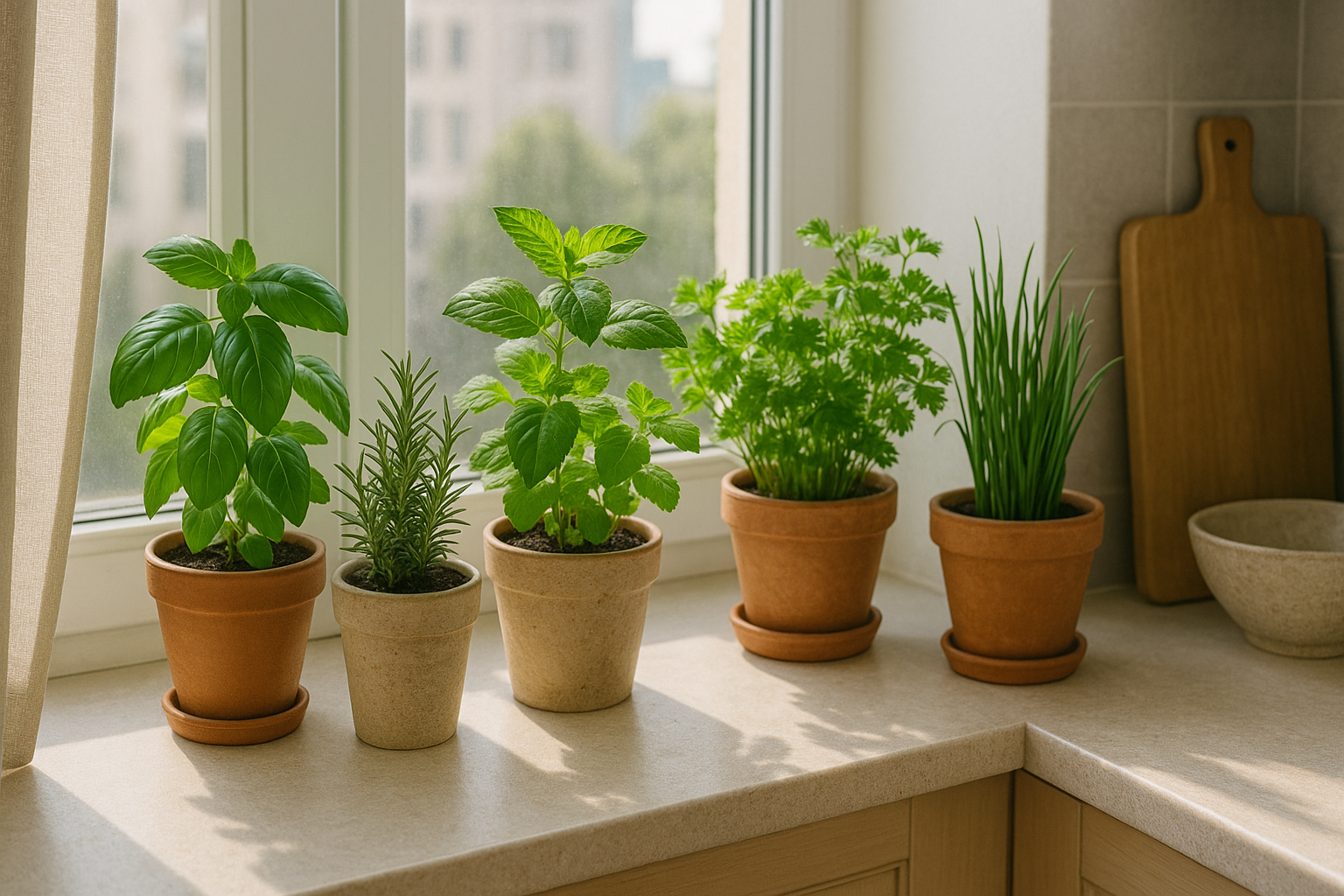Imagine cooking a fresh meal and reaching over to pluck fragrant basil, crisp parsley, or zesty mint from a sunny kitchen windowsill. Growing herbs indoors isn’t just a charming idea — it’s an accessible, practical, and satisfying way to bring flavor and freshness into your home. Even if you live in a compact apartment, your kitchen can become a mini herb garden.
In this complete guide, we’ll explore which aromatic herbs thrive best in indoor kitchens, what you need to grow them successfully, and essential care tips to keep them lush all year round.
Why Grow Herbs Indoors?
Indoor herb gardening goes far beyond adding greenery to your kitchen. Here are several benefits:
- Convenience: Fresh herbs within arm’s reach while cooking.
- Flavor: Fresh-cut herbs have more aroma and potency than dried store-bought options.
- Cost-saving: Grow once, harvest for months — no more buying bundles that go bad in the fridge.
- Air quality: Many herbs help purify indoor air.
- Therapeutic effects: Gardening, even in small spaces, reduces stress and promotes well-being.
Plus, herbs are low-maintenance, making them perfect for beginners and busy people alike.
Light, Soil, and Other Essentials
Before diving into your herb selections, let’s cover the basics of what indoor herbs need to thrive.
1. Light
Most herbs need 4–6 hours of sunlight per day. Place them in east- or west-facing windows, which provide soft morning or afternoon light. South-facing windows (in the Northern Hemisphere) offer the strongest light and suit sun-loving varieties like basil and rosemary.
If your kitchen doesn’t get enough natural light, consider using LED grow lights — they’re affordable, energy-efficient, and mimic natural sunlight.
2. Pots and Drainage
Use pots with drainage holes to prevent water buildup and root rot. Clay or terracotta pots are great options because they absorb excess moisture.
Place trays or saucers underneath to catch water runoff and protect your kitchen surfaces.
3. Soil
Use a well-draining potting mix, ideally one formulated for herbs or vegetables. Avoid compacted garden soil, which retains too much water and can suffocate roots.
A mix of potting soil, compost, and a bit of perlite or sand can provide a loose, rich-growing medium.
4. Watering
The biggest mistake with indoor herbs? Overwatering. Most herbs prefer the soil to dry slightly between waterings.
Check the top inch of soil — if it’s dry, it’s time to water. Always water at the base, not over the leaves.
10 Best Herbs to Grow in Your Kitchen
These herbs are not only flavorful but also adaptable to indoor conditions:
1. Basil
Perfect for pastas, pizzas, and salads. Loves warmth and lots of sun. Keep soil moist but not soggy. Pinch flower buds early to extend leaf production.
2. Mint
Refreshing and versatile — great in teas, desserts, and salads. Prefers indirect light and moist soil. Tip: Always grow mint in its own pot — it spreads aggressively.
3. Parsley
Takes a little longer to germinate but is worth the wait. Flat-leaf parsley has more flavor than curly. Needs moderate light and evenly moist soil.
4. Rosemary
A woody herb with a pine-like fragrance. Loves full sun and well-drained soil. Water sparingly and trim regularly to encourage bushy growth.
5. Thyme
Low-growing and easy to care for. Thrives in full sun with minimal water. Excellent in soups, marinades, and roasted dishes.
6. Chives
Mild onion flavor, perfect for eggs and soups. Grows well in small pots with plenty of light. Harvest by snipping leaves about 2 cm above soil level.
7. Oregano
A Mediterranean favorite that thrives in bright light. Needs less water than leafy herbs. Use fresh or dry for pizza, pasta, and sauces.
8. Cilantro (Coriander)
Fast-growing but bolts quickly in heat. Best in cooler spots with moderate light. Harvest often to prevent flowering.
9. Lemon Balm
Bright, lemon-scented leaves are ideal for teas and salads. Prefers indirect light and rich soil. Prune regularly to prevent it from becoming leggy.
10. Bay Laurel
Grows into a small tree in the right conditions. Use dried leaves in soups and stews. Needs a larger pot and lots of sun.
Creative Ways to Display Your Indoor Herb Garden
Short on space? These ideas can help you fit herbs into any kitchen layout:
- Windowsill trays: Line up small pots on your kitchen window ledge.
- Hanging planters: Suspend herbs near light-filled windows.
- Magnetic containers: Attach small pots to your fridge or backsplash.
- Vertical racks or tiered shelves: Create a beautiful “green wall” effect.
- Recycled jars and cans: Sustainable and stylish with proper drainage added.
Make it part of your kitchen decor — it’s functional and aesthetic!
Care Tips for Long-Lasting Herbs
To ensure your herbs stay healthy and productive:
- Prune frequently: Regular cutting promotes growth and prevents flowering.
- Fertilize lightly: Use diluted organic fertilizer once a month.
- Rotate pots: Turn them weekly to prevent uneven growth toward the light.
- Watch for pests: Aphids or spider mites can appear. Spray with a water-soap solution if needed.
- Repot if root-bound: If roots are crowding, move to a slightly larger pot.
Troubleshooting: Common Herb Growing Issues
- Leggy stems? Not enough light — move to a sunnier spot or use a grow light.
- Yellowing leaves? Likely overwatering or poor drainage.
- No aroma or weak flavor? Could be due to lack of sunlight or old soil.
Always observe your plants — they show you what they need.
From Seed to Satisfaction
Indoor herb gardening is one of the most rewarding low-effort hobbies. It brings nature indoors, enriches your meals, and gives you a moment of peace each time you water, trim, or smell fresh leaves.
Whether you start with a single basil plant or build an entire herb wall, the results are gratifying. With just a bit of attention and light, your kitchen can become a living pantry full of flavor and freshness.
